
The Importance of Safety Signage on Construction Sites
Construction safety signs are a critical part of any job site—alerting workers to hazards, guiding safe movement, and ensuring compliance with safety regulations. From preventing accidents to improving workflow, these signs protect lives and keep projects running smoothly. By using high-quality safety signage, construction teams can reduce risks, meet legal standards, and maintain a professional and secure work environment.
Protecting lives and meeting regulations
Construction site safety signs are not just regulatory checkboxes—they’re life-saving tools. These signs alert workers and visitors to potential hazards, direct safe movement throughout the site, and ensure compliance with local and federal safety codes. Using proper signage can also help avoid costly fines or work stoppages due to violations.
Preventing accidents and promoting efficiency
Proper signage drastically reduces accidents—from falls to exposure to dangerous substances. When every zone and process is clearly marked, operations become more efficient. Workers know where to go, what to do, and what to avoid, creating a more organized and productive site.
What this article will cover
In this post, we’ll break down the different types of safety signs commonly used in construction sites, their specific purposes, key safety standards, and how a professional team like Sign Depot ATX can help implement them properly to ensure both safety and compliance.
Hazards on the job site
Construction sites are filled with diverse and ever-changing risks. These may include the operation of heavy equipment, constant vehicle traffic, exposure to toxic substances, and partially completed structures. Each of these elements can pose serious threats to workers, managers, and visitors if not properly addressed.
How signage helps prevent accidents
Safety signs serve as a key tool in reducing on-site incidents. Clear and visible messages alert personnel to danger zones, special conditions, or required behaviors—such as “Do Not Enter,” “Hard Hat Required,” or “Flammable Materials.” In one real-world case, using “Restricted Area” signs prevented unauthorized personnel from entering a space where hazardous chemicals were being handled, avoiding potential exposure.
Legal compliance and avoiding penalties
Beyond safety, signage plays a critical role in meeting legal and workplace safety standards. Regulations like those from OSHA require specific signage in various construction settings. Failing to meet these standards not only endangers lives but can also lead to hefty fines or shutdowns, severely impacting the progress and cost of a project.
Prohibition Signs: What Not to Do
Prohibition signs are essential in construction environments to prevent hazardous actions. These red signs indicate behaviors that are strictly forbidden, such as smoking, unauthorized entry, or operating equipment without permission. They are especially critical in high-risk areas where a single mistake could lead to serious injury.
These signs are typically placed at entrances to restricted areas or in locations where dangerous machinery is in use. Common examples include “No Entry,” “Do Not Operate Machinery,” and “No Smoking.”
Typical design and visual clarity
Prohibition signs follow a universally recognized design: a red circle with a diagonal slash across it, set against a white background. This instantly recognizable format ensures that the warning is clear, even to non-native speakers or from a distance.
Warning signs are essential tools to prevent accidents in public areas, construction zones, schools, or industrial facilities. Their distinctive design—yellow background with a black triangle—is intended to quickly capture attention and alert about a specific danger.
Unlike other signs that indicate mandatory actions or prohibitions, these signs don’t demand a specific response. Instead, they signal caution. Some classic examples include: “Slippery When Wet” or “Falling Debris.”
These signs are especially useful in environments where conditions can suddenly change, or where lack of awareness could lead to injury. Adding them shows a strong commitment to safety and can help avoid costly incidents.
They can also be customized with icons, specific wording, or size adjustments, making them highly adaptable across different contexts. If you plan to use them, make sure they comply with local safety regulations and are placed in highly visible areas.
Emergency and Safe Condition Signs: Where to Go
Green signs for emergency exits, first aid kits, and safe routes. Red (not prohibitive) for fire equipment location
Emergency and safe condition signs play a vital role in evacuation scenarios or medical emergencies. Green signs are used to indicate safe areas, emergency exits, first aid stations, or assembly points. Common examples include “Emergency Exit”, “First Aid”, or “Evacuation Route.”
Meanwhile, red signs—not to be confused with prohibition signs—identify the location of fire-fighting equipment, such as extinguishers, hoses, or fire alarms. A typical example is “Fire Extinguisher.”
During moments of stress or panic, having clear, visible signage can be life-saving. These signs help people find safety, medical assistance, or the nearest way out in an organized manner.
Using universal icons ensures quick understanding, even across language barriers. It’s also crucial that these signs are made with durable, photoluminescent materials so they remain visible in low-light conditions or power outages.
Standards like OSHA and ANSI require specific safety signage
Safety signage isn’t just good practice—it’s a legal requirement in many environments. In the U.S., organizations like OSHA (Occupational Safety and Health Administration) and ANSI (American National Standards Institute) define regulations for where, how, and what types of safety signs must be used.
For example, OSHA mandates the use of specific signs for hazards, emergency equipment, evacuation routes, and restricted zones. Failure to comply can result in substantial fines, failed inspections, or even legal liability in case of an incident.
In industries like construction, education, or food services, these regulations are often stricter. That’s why many organizations choose to work with a professional consultant to assess their facilities, identify gaps, and ensure full compliance with current signage laws.
Beyond avoiding penalties, complying with these standards reinforces a commitment to safety and communicates responsibility to employees and visitors alike.
Designing Effective Safety Signage
Clarity and Simplicity in Messaging
Safety signs are only effective when their message is understood instantly. That’s why clarity and simplicity are essential. Text should be direct, avoid jargon, and be paired with universally recognized symbols—especially in environments where visitors or workers may not speak the local language.
Common mistakes include overly long messages, poor translations, or using abbreviations that create confusion. For instance, a sign warning about “hazardous material” loses value if it’s faded or displayed at the wrong angle.
Durability matters too. Signs placed outdoors must be made from weather-resistant materials that can withstand sun, rain, and abrasion—like those found in these construction sign options. Additionally, signs should have high contrast, legible fonts, and appropriate size to ensure visibility from a distance and from various angles.
Positioning signs at entry points, hazard zones, rest areas, and exits
In a construction site, where you place the signs is just as important as what they say. Signs should be installed in critical locations such as entrances, high-risk zones, emergency exits, and rest areas—places where safety information is most needed.
Poor placement leads to confusion, disrupts workflow, and increases the risk of accidents. To avoid this, ensure that signs are mounted at eye level, positioned at a clear angle of visibility, and placed consistently throughout the entire site.
Additionally, choosing materials that blend well with the site infrastructure enhances both durability and aesthetics. A smart solution for ongoing projects is using construction fence wraps, which communicate essential messages without adding clutter.
How Our Expert Signage Solutions Add Value
Working with a specialized signage provider ensures more than just technical quality—it means each sign is designed for maximum effectiveness while visually aligning with your brand.
A well-executed signage system can elevate a construction site’s image, showing professionalism, organization, and a strong safety culture. When you work with us, you’re not just getting signs—you’re getting solutions that fully comply with standards like OSHA and ANSI, helping you avoid penalties and legal issues.
From concept and graphic design to material selection and on-site installation, we manage the entire process to deliver high-quality, long-lasting signage. Every project is different, which is why we tailor our solutions to your specific needs while keeping user experience and communication clarity at the center.
Ready to elevate your project with professional signage? Get in touch with us today to receive personalized advice and solutions designed to keep your site safe, compliant, and visually aligned with your brand.
Safety Signage: A Smart Investment That Saves Lives
Safety signage isn’t just a legal box to check—it’s an essential communication tool that protects lives and prevents costly mistakes. It’s a visual language that guides, informs, and safeguards, especially in high-risk environments.
Investing in effective signage is not an expense—it’s a strategic move. A well-placed, well-designed sign can prevent accidents, assist in evacuations, and project a professional image at a glance. It also helps build a strong culture of safety that resonates throughout your team and worksite.
Contact Information
- Address: 12110 Manchaca Rd. Suite 200, Austin, TX, 78748
- Email: wecare@signdepotatx.com
- Phone: 512 219 8000
From our perspective, the difference between a functional site and a truly safe one often comes down to how signage is planned, designed, and implemented.
Why Choose
Custom Murals
How to Choose the
Right Artist in Austin, Texas
Types of Custom
Murals Available
The Creative Process
Behind a Custom Mural
Inspiration for
Your Next Project
COMPLETE THE FORM
CHECK OUR WORK
FAQ’S
What are the benefits of using outdoor window clings for my business in Austin?
Outdoor window clings offer an easy-to-install, cost-effective, and reusable signage solution. They help businesses enhance their storefronts with eye-catching branding, promotions, or seasonal messages without the need for permanent adhesives.
How do outdoor window clings compare to traditional vinyl decals?
Unlike permanent vinyl decals, outdoor window clings can be easily applied and removed without leaving residue. They are a great choice for temporary promotions, seasonal updates, or businesses that frequently change their messaging. Compared to large window decals for business, clings offer greater flexibility and easier maintenance.
Can outdoor window clings withstand Austin’s weather conditions?
Yes! Our outdoor window clings are designed to resist prolonged sun exposure, humidity, and temperature changes. They maintain their vibrant colors and adhesion, making them a durable signage solution for businesses in Austin.
How do I install outdoor window clings without bubbles or wrinkles?
To ensure a smooth installation, clean the glass thoroughly, position the cling before applying, and use a rubber squeegee to remove air bubbles. For best results, we recommend using a spray bottle with soapy water during application.
Where can I get high-quality outdoor window clings in Austin?
At Sign Depot ATX, we specialize in designing and installing custom outdoor window clings in Austin. Contact us today for a free consultation, and let us help you create the perfect signage solution for your business!
Find Us in Austin, Texas
12110 Manchaca Rd. Suite 200 Austin, TX, 78748
Email: wecare@signdepotatx.com
Phone: 512 219 8000


